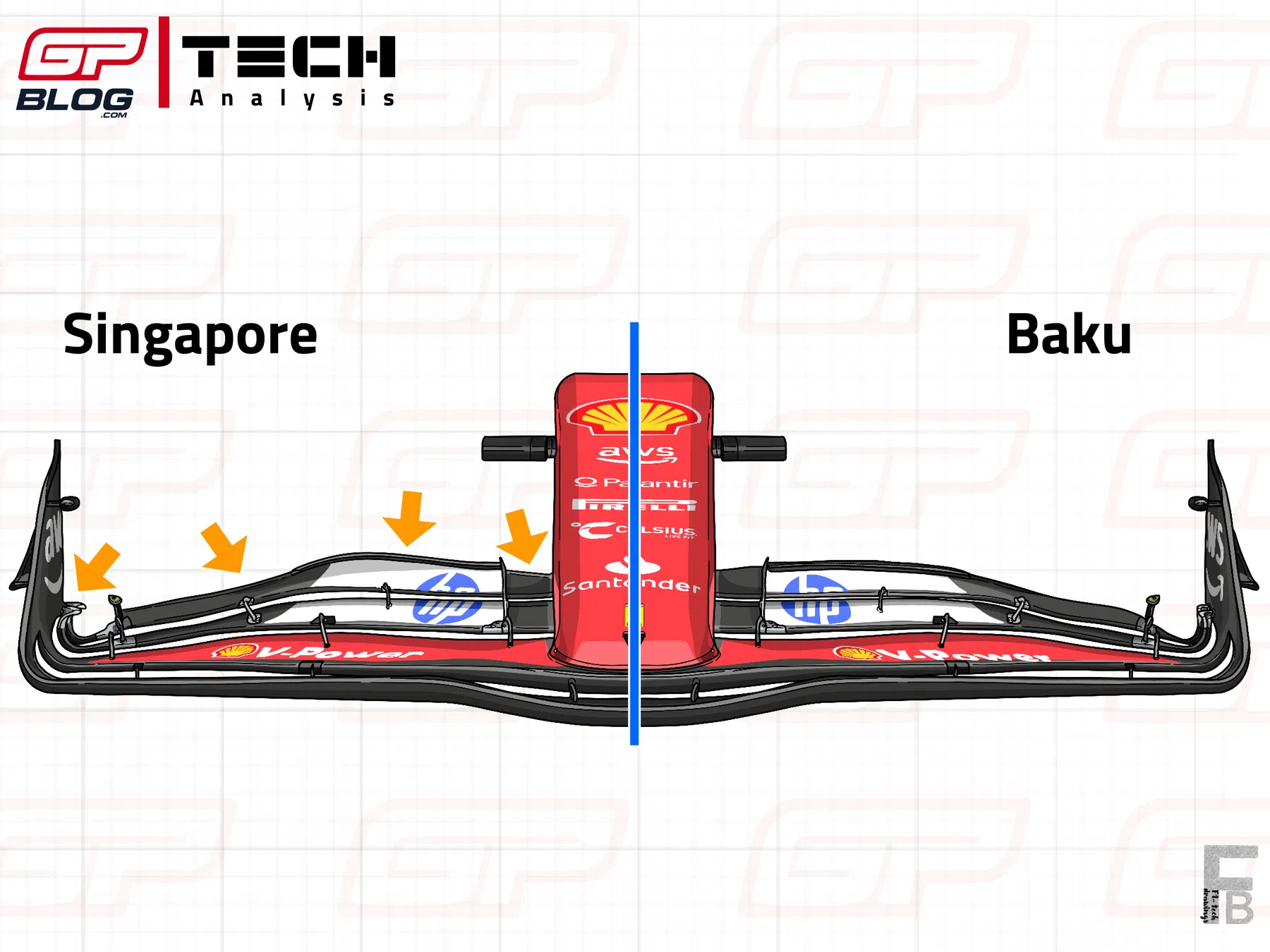Tech

Tech Analysis | How a bad qualifying compromised Ferrari's potential winning weekend
Ferrari arrived at Singapore on a high after two very competitive weekends in Monza and Baku and the Italians were confident that the Marina Bay Street Circuit would have suited the SF-24 very well. The car looked very fast since Friday's FP1 also thanks to the new front wing, but some issues with the tyres on Saturday compromised what could have possibly been a victorious weekend for the Maranello-based team. Let's try to understand why.
A new front wing to balance the car on high downforce tracks
For the occasion, the team introduced a newly designed front wing, which was expected to better balance the car on high downforce circuits: as highlighted in the drawing below, the new wing features a completely different design in the third and fourth flaps, as well as in the metal supports that connect it to the endplate. As for the third and fourth flaps, they show a very similar shape to those of the front wing of the SF-23, with a curvilinear front designed to increase the amount of downforce generated in the innermost portion, to then "unload" towards the endplate to improve the outwash effect and push the air outside the front wheel. As highlighted by the orange arrows, the element that connects the fourth flap to the nose has also slightly revised, as it has a shorter chord and a different attachment.
The aim of this new design is to increase the local load generated by this new spec, by better directing the flow that hits the central portion of the wing towards the bodywork, while the flow that hits the outermost portion of the wing towards the outside of the front wheel, also mitigating the way in which the front tyre wake is managed.

In this regard, the two metal supports that connect the third and fourth flaps to the endplate have also changed: as highlighted in the drawing below, while these previously had a much more linear shape, they now have a much more "twisted" shape, to generate vortices useful for pushing the front tyre wake outwards, preventing the harmful turbulence generated by the contact patch from ending up under the Venturi channels.

This solution has many similarities with the metal supports that appeared on the McLaren car during the Austrian Grand Prix, when the Papaya team introduced a similar solution.
This new component had the main goal to better balance the SF-24, as senior performance engineer Jock Clear underlined on the Friday of the Singapore weekend: "It's just moving the energy a little bit inboard. So if you look at it closely you'll see that the inboard is a bit more aggressive and the outboard is a bit less aggressive, so you've moved that dynamic a bit. It allows us to actually crank on a bit more, which here you're probably going to want because you've got maximum rear downforce, and you're going to want to get a balance, and balance is everything around here. And we've been a little bit backed into a corner at some of the high downforce circuits before, because we're running at a front power basically, so it's just a little bit more powerful at the top end. Slightly more efficient, marginally, it's the fact that it's a little bit more powerful at the top end that gives us a bit more scope.”
After some back to back tests during Friday’s FP1, both Sainz and Leclerc kept on using the new spec for the rest of the weekend and it definitely work as expected: the SF-24 was extremely competitive in slow speed corners and was also very aggressive on kerbs, proof of a very well-centred mechanical set-up.
However, even though the competitiveness of the Ferrari car on Friday deceived fans that they could have fought with McLaren for the rest of the weekend, the scenario drastically changed during Saturday’s qualifying: after a very competitive Q1 and Q2, Q3 was a nightmare, with Carlos Sainz spinning off and Leclerc’s lap got deleted.
The cause behind the horrible performance was related to the tyres: in both cases, tyres weren’t in their optimal working window and caused a loss of grip. As usually happened this season and as pointed out by Russell after Baku, tyres are a very difficult but crucial component to understand, and it’s fundamental to make them work correctly to be quick.
Despite the bad performance over the single lap, the SF-24 came back to the top form during Sunday’s race, with a very competitive pace especially on the hard tyres.
In conclusion, teams will now have a full month of hard work and activity to make progress on their projects and bring the last new pieces in the next few rounds. Vasseur and Horner confirmed that both Ferrari and Red Bull will have their latest package in Austin, while is still unknown when McLaren will unveil their new bits. Despite a full month of stop is going to be quite disappointing for all the fans, it’ll be extremely exciting to see how the performances among top teams will change once they all have modified their cars.
Want more Formula 1? Then follow GPblog on our various social media channels!

